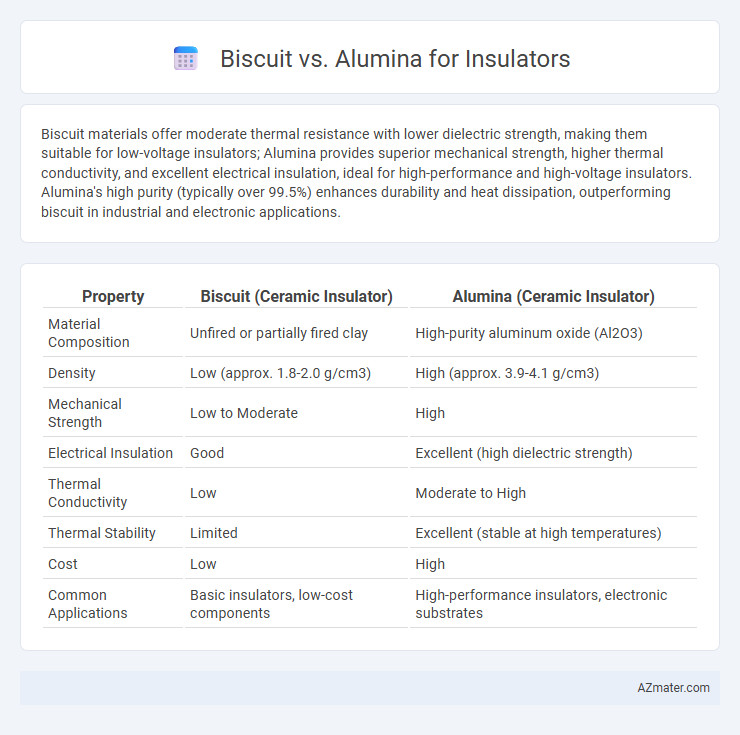Biscuit materials offer moderate thermal resistance with lower dielectric strength, making them suitable for low-voltage insulators; Alumina provides superior mechanical strength, higher thermal conductivity, and excellent electrical insulation, ideal for high-performance and high-voltage insulators. Alumina's high purity (typically over 99.5%) enhances durability and heat dissipation, outperforming biscuit in industrial and electronic applications.
Table of Comparison
| Property | Biscuit (Ceramic Insulator) | Alumina (Ceramic Insulator) |
|---|---|---|
| Material Composition | Unfired or partially fired clay | High-purity aluminum oxide (Al2O3) |
| Density | Low (approx. 1.8-2.0 g/cm3) | High (approx. 3.9-4.1 g/cm3) |
| Mechanical Strength | Low to Moderate | High |
| Electrical Insulation | Good | Excellent (high dielectric strength) |
| Thermal Conductivity | Low | Moderate to High |
| Thermal Stability | Limited | Excellent (stable at high temperatures) |
| Cost | Low | High |
| Common Applications | Basic insulators, low-cost components | High-performance insulators, electronic substrates |
Introduction to Insulators: Biscuit vs Alumina
Biscuit and alumina are two primary materials used in the manufacturing of electrical insulators, each offering distinct advantages in insulation performance and mechanical strength. Biscuit insulators, typically made from engineered ceramic composites, provide excellent thermal stability and resistance to environmental degradation, making them suitable for medium-voltage applications. Alumina insulators, composed of high-purity aluminum oxide, are preferred in high-voltage and high-temperature environments due to their superior dielectric strength and exceptional mechanical robustness.
Material Composition and Manufacturing Process
Biscuit insulators are primarily made from fired clay or porcelain, characterized by a high alumina content mixed with other ceramic materials, providing excellent electrical insulation and mechanical strength. Alumina insulators consist almost entirely of high-purity aluminum oxide (Al2O3), produced through advanced powder processing and sintering techniques that result in superior thermal stability and dielectric properties. The manufacturing process of biscuit insulators involves kiln firing to achieve hardness and durability, while alumina insulators undergo precise molding and high-temperature sintering to enhance density and minimize porosity, optimizing performance in high-voltage applications.
Physical and Mechanical Properties Comparison
Biscuit insulators, typically made from high-strength porcelain, exhibit excellent mechanical strength with high compressive and tensile resistance, making them suitable for heavy-duty electrical applications. Alumina insulators, composed of advanced ceramics with over 99% alumina content, surpass biscuit insulators in hardness, wear resistance, and thermal conductivity, enhancing their durability under extreme temperature and mechanical stress. The superior dielectric strength and lower porosity of alumina insulators result in better electrical insulation performance compared to traditional biscuit porcelain materials.
Electrical Performance: Dielectric Strength
Biscuit insulators typically offer moderate dielectric strength, suitable for low to medium voltage applications, but Alumina insulators exhibit superior dielectric strength, often exceeding 300 kV/mm, making them ideal for high voltage and critical electrical insulation. Alumina's high purity and crystalline structure provide exceptional electrical resistance and thermal stability, ensuring minimal leakage current and improved insulation reliability under extreme conditions. In contrast, biscuit insulators, made from fired clay or porcelain, have lower dielectric performance, limiting their effectiveness in environments requiring high electrical endurance.
Thermal Stability and Heat Resistance
Biscuit insulators, made from clay-based materials, exhibit moderate thermal stability suitable for low to medium temperature applications but have limited heat resistance under prolonged high-temperature exposure. Alumina insulators, composed predominantly of aluminum oxide with high purity levels (typically above 99%), offer superior thermal stability and exceptional heat resistance, maintaining mechanical strength and electrical insulation properties at temperatures exceeding 1600degC. The higher melting point and thermal conductivity of alumina make it preferable for high-stress environments requiring reliable performance under extreme heat conditions.
Moisture Absorption and Weathering Effects
Biscuit insulators exhibit higher moisture absorption rates compared to alumina, leading to increased susceptibility to surface contamination and reduced insulating performance over time. Alumina insulators show superior resistance to weathering effects such as UV radiation, temperature fluctuations, and chemical corrosion, maintaining mechanical strength and electrical properties in harsh environments. Moisture absorption in biscuit insulators can cause microcracks and dielectric degradation, whereas alumina's dense ceramic structure ensures minimal moisture ingress and enhanced longevity in outdoor applications.
Cost Analysis and Economic Considerations
Biscuit insulators generally offer lower initial costs compared to alumina insulators, making them more economical for large-scale, budget-sensitive projects. Alumina insulators, despite their higher upfront price, provide superior mechanical strength and longer lifespan, reducing maintenance and replacement expenses over time. Economic considerations favor alumina when factoring in total cost of ownership, especially in high-voltage or harsh environmental conditions where durability is critical.
Applications in Electrical Systems
Biscuit insulators, made from fired clay or porcelain, offer excellent mechanical strength and are commonly used in medium-voltage distribution lines and switchgear where cost-effectiveness and durability are critical. Alumina insulators, composed of sintered aluminum oxide, exhibit superior dielectric strength and thermal stability, making them ideal for high-voltage and high-temperature applications such as power transformers, circuit breakers, and high-frequency components. Their enhanced electrical insulation properties and resistance to corrosion extend equipment lifespan in harsh industrial environments and demanding electrical systems.
Environmental Impact and Sustainability
Biscuit insulators, typically made from porcelain clay, offer excellent durability but have higher energy consumption and CO2 emissions during kiln firing compared to alumina insulators, which are manufactured through more energy-efficient processes. Alumina insulators benefit from lower environmental impact due to their longer life span and recyclability, reducing landfill waste and resource extraction. The sustainability advantage of alumina lies in its resistance to weathering and chemical degradation, which decreases replacement frequency and overall ecological footprint.
Future Trends in Insulator Materials
Biscuit insulators, traditionally made from porcelain, offer excellent mechanical strength and electrical insulation but face limitations in weight and fragility, driving research toward alumina-based insulators due to their superior thermal stability, higher dielectric strength, and enhanced resistance to environmental degradation. Future trends in insulator materials emphasize nanostructured alumina composites and hybrid ceramics to achieve lighter, more durable, and eco-friendly insulators that support higher voltage levels and improved grid reliability. Innovations focus on integrating alumina with smart sensor technologies to enable real-time monitoring and predictive maintenance, fostering smarter and more resilient energy distribution networks.

Infographic: Biscuit vs Alumina for Insulator
 azmater.com
azmater.com